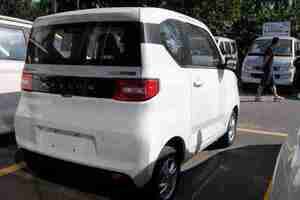What China can teach us about selling EVs by the truckload
Despite the pandemic, global sales of electric vehicles (EVs) increased by 43% in 2020 . Total EV sales in China were 1.3 million, an increase of 8% compared to 2019 , and 41% of all EVs sold worldwide. Though Europe sold more than China for the first time since 2015, China is still the world’s biggest national market for EVs.

The best-selling EV in China is not Tesla’s Model 3, but the tiny Hongguang Mini EV, produced by SAIC-GM-Wuling Automobile, a joint venture between China’s state-owned SAIC Motor, US carmaker General Motors and another Chinese company, Wuling Motors.
The conglomerate positions the car as “the People’s Commuting Tool” in its advertising, with a starting price of 28,800 yuan (about US$4,485, or £3,200) and a fully charged driving range of 120km. Since its debut in July 2020, the Hongguang Mini EV has sold over 270,000 units and was the best-selling EV worldwide in January 2021.


This was quite a surprise, as Chinese consumers have traditionally preferred larger models with internal combustion engines . But our recent research on consumer preferences in China reveals significant market opportunities for EVs in small cities and how innovative business models could encourage even more people to ditch their fossil-fuelled cars.
EVs in big and small cities
China aims to reach a peak in its carbon emissions before 2030 and achieve carbon neutrality by 2060 . Since 2009, the Chinese government has offered subsidies and tax waivers and built charging points to encourage EV buyers and manufacturers.
But those subsidies are now drying up . Finding out what Chinese motorists like in EVs could tell us what’s behind growth in the world’s largest national market, and whether it’s likely to continue or stall. This matters not only for China but the rest of the world. China has been the world’s largest emitter since 2006, and internal combustion engine cars are among the biggest sources of carbon emissions globally.
In a recent study , we found that most EV sales are made in China’s large cities – those with over five million residents, such as Shanghai and Beijing – largely due to the stronger policy incentives there. But consumers in small cities – each with fewer than a million residents – were the most keen to drive EVs.
In these small cities, drivers tend to enjoy shorter commutes and so have less pressure on their time and living costs. People there tend to care more about how well the vehicle works and the environmental benefits of EVs. Prior research revealed that these consumers are less likely to buy an EV if it’s the more expensive option. This might explain why Hongguang’s Mini EV – with its limited range and relatively cheap price – originated in Liuzhou of Guangxi province, a small city in the south-west of China.
Larger cities in China commonly implement car plate lotteries that limit the number of petrol cars licensed each year. The lottery winning rate is smaller than 1%, about 0.0039% in Beijing , so motorists here have no choice but to switch to EVs. Our findings suggest that the Chinese government’s focus on getting people to drive EVs in larger cities may be misplaced.
Smaller Chinese cities demonstrate a desire for cheap, electrified mobility that could be satisfied there and across the world, particularly the burgeoning towns and cities of the developing world. In short, the future of EVs may look very different to the luxury Tesla cars currently attracting the most attention.
Buy, lease or share EVs?
To get more people driving EVs, manufacturers have tried new business models in the Chinese market, such as battery leasing plans. The battery is one of the most expensive components of an EV and this scheme allows consumers to buy the vehicle’s body, then lease the battery on a monthly basis.
Our second study showed that the battery leasing model will probably broaden the appeal of EVs by appealing to people currently put off by the price.
Some EV companies which have introduced battery-leasing models have also offered a service where drivers can replace their empty batteries with a fully charged one at a service station – a much faster transaction than recharging.
We found that it didn’t matter to drivers whether they rented their battery or completely owned the car. Consumers were ready to accept the battery-leasing model because that and battery swapping services help remove two barriers to buying EVs simultaneously: the premium price and long charging wait times.
Separating EV bodies and batteries can even make driving them more sustainable. When the batteries can no longer sustain long-distance driving, they can be reconfigured for a second life in grid-connected storage and electrical tools. At the same time, the owners can continue using the EV bodies without needing to renew the batteries or scrap their vehicles.
Our research also looked at EV sharing schemes, such as EV-Card , in which people can just hop in a vacant EV and drive it if they join a membership scheme. They’re charged for using the EV by the minute. Low-income households were most likely to use this service, potentially making it an effective way of broadening their appeal.
Collectively, a picture emerges of promising ways to deliver the decarbonisation of urban mobility – in China and around the world. Rather than subsidising wealthier consumers in megacities to switch to an EV, a more promising strategy may be to focus on novel forms of access to EVs in China’s – and the world’s – smaller and less wealthy cities.
Self-driving AI is not just for cars — it’s coming to ebikes too
In the hype around getting our cars to drive us around, it’s easy to forget that Advanced Driver-Assistance Systems (ADAS) have a higher function – to radically improve road safety , by reducing the number of accidents.

Recently, this intention has transitioned to ebikes. As our bikes become small (ok, pretty small) data centers on wheels, their ability to monitor our surroundings becomes a catalyst for companies creating technology that provides cyclists with some of the safety insights available in connected cars.
Bike riders are far more vulnerable than their car driving companions, and tech that ebike companies can adapt to suit cyclists can only be a good thing.
ADAS monitoring can provide riders with the ability to gain insights into the unseen. Like what’s behind them and in their blind spots as they ride. These systems can detect, classify and track objects by using advanced computer vision, machine learning algorithms, and deep neural networks.
This leads to an assessment of threats and the level of risk on the road, helping cyclists make riding decisions in real-time. There are currently three leading companies working on a suite of offerings:
Blinc Bike (Terranet)
The most recent offering announced this month is Blinc Bike by Terranet .
The company is developing a new class of Rear-View monitoring to keep an eye on the things happening behind the cyclist with a 180 degrees wide view.
Blinc Bike uses two easily attachable and detachable parts. A Rear View Display is placed on the handlebars and a rear light placed underneath the bike seat.
The camera detects, classifies, and tracks objects invisible to a cyclist. It alerts the user either on the front display or through haptic feedback when there is anything that needs immediate attention.
For example, if a car suddenly approaches from behind, the cyclist will receive a warning on the Front Rear View Display mounted on the handlebars and/or through haptic feedback on their choice of a wrist band, leg straps, or bike grips.
This helps the cyclist to avoid making any drastic turns that can cause a collision with the identified object.
A smart tail light will indicate the cyclist’s actions to the upcoming traffic: braking, moving, or stopping.
Streetlogic
Founded in 2020, Streetlogic has developed a suite of connected devices to identify and alert riders of vehicles approaching from behind, either side or in front of you – a full 360-degree view. Riders can receive notifications on the heads-up display or audio alerts through a built-in loudspeaker or corresponding app.
The dashcam is always on without charging cameras or replacing SD cards and automatically saves footage of collisions or close calls. These are sent directly to your smartphone.
The company recently raised $2.1 million in pre-seed funding. Customers can preorder Streetlogic’s ADAS with a $30 downpayment. The company intends to start product delivery in late 2022 at a price between $300 to $400.
Holoscene X (Boreal bikes)
German startup Boreal bikes was founded in 2014. It focuses on using cellular networks, sensors, and LPWAN to facilitate Vehicle-to-Everything (V2X) communication and increase safety.
The company seems to be operating largely in stealth. There’s not much in terms of details of their upcoming creation, Holoscene X.
Holoscene X is an ebike that uses V2X to deliver “collision avoidance and interactive speed adjustment blind-spot detection, and roadblocks warnings.” It comes equipped with sensors and cameras to enable the bike to monitor, respond to and communicate with surrounding vehicles.
The ebike is embedded with a NVIDIA GPU-powered supercomputer. It’s perfect for devs who cycle.
The company asserts: “With the Holoscene X and its bundled dev tools, you’ll be able to explore, develop, test, integrate and implement tomorrow’s Edge applications today.”
This suggests an interesting bike that would be great for garage hackers.
The company comes with a history for innovation. The founders were previously working on smrtGRiPS , the world’s first connected smart grips in 2015. The bike grips and their corresponding app aimed to facilitate haptic notifications, eyes-free navigation, separation alerts, and bike tracking.
However, they couldn’t raise enough funding to go to market, alas. But their initiative is pretty impressive for relatively early consumer IoT, let alone a connected bike product.
I think they’ll have received some great learnings that the team will reflect in their current work. The release date for Holoscene X is at this date, unknown.
UK installs 4,000th EV rapid charger — and it’s just getting started
The UK is slowly but surely getting up to speed with fast-charging connectors.

According to EV charging infrastructure trackers, Zap-Map, the UK now has 4,000 rapid chargers installed.
In a tweet posted earlier today, Zap-Map declared that it’s now tracked the rapid chargers, which are installed at 2,667 locations. Zap-Map classes a rapid charger as anything capable of delivering more than 50 kW DC of power to an EV.
For comparison, according to Nederland Elektrisch , the Netherlands — which has 1/3rd the population of the UK — has over 1,850 EV fast-chargers installed at the start of this year. The Netherlands also has the fastest growing charging network in the world .
The new figures show that the UK has added just over 1,000 rapid chargers over the past year, but if they want to catch up to the Dutchies (chargers per capita) they have to keep up this rapid advance. Still, the UK’s increase is great news for long distance drivers of high-performance EVs.
Most rapid chargers are capable of charging the average EV from zero to 80% charge in well under an hour.


In January of last year , the UK passed the 30,000 connector mark and has since gone on to add another 7,000 chargers of all types over the past 12 months.
Around 30% of the UK’s EV chargers are located in Greater London and the South East, where most of the people are anyway.
New chargers are always good news for EV drivers. Rapid chargers even more so, as they are the best tool we have right now for long-distance, low-hassle electric motoring.
As government bans on the sale of new combustion engine vehicles come into force in the next decade, the UK will see a large scale development of EV charging infrastructure.
Companies like GridServe, which opened its first dedicated EV charging service station last December , has plans to open over a hundred in the country in coming years.
One thing is for sure, the country needs more locations like this if it’s to support a future of electric vehicles. Indeed, it’s great to see the UK surely and steadily adding more EV chargers every week, but this is very much still the beginning.
SHIFT is brought to you by Polestar. It’s time to accelerate the shift to sustainable mobility. That is why Polestar combines electric driving with cutting-edge design and thrilling performance. Find out how .